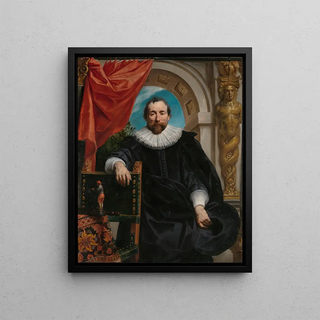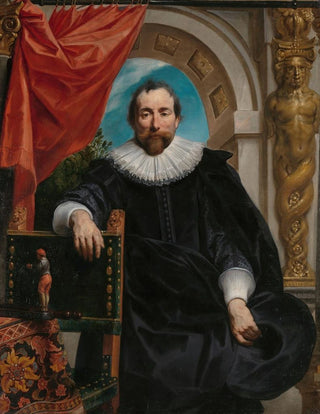Art print | Portrait of Rogier Le Witer - Jacob Jordaens


View from behind

Frame (optional)
Portrait of Rogier Le Witer - Jacob Jordaens – Captivating Introduction
In the vast panorama of Flemish art history, Jacob Jordaens' "Portrait of Rogier Le Witer" stands out for its intensity and psychological depth. This 17th-century artwork embodies not only Jordaens' undeniable talent but also the spirit of an era when painting became a mirror of social and cultural values. The portrait, depicting a man with penetrating eyes and a resolute attitude, invites viewers to reflect on the identity and status of its subject. The finesse of details and the richness of colors evoke a vibrant atmosphere, transporting the viewer into a world where art and life blend seamlessly.
Style and uniqueness of the work
Jordaens' style is characterized by striking realism, masterful use of light, and a warm color palette that gives his works an almost tactile dimension. In the "Portrait of Rogier Le Witer," each brushstroke seems imbued with a life of its own, making the subject almost palpable. The textures of clothing, the play of shadows and light on the face, and the subtle expression of emotions all demonstrate exceptional technical mastery. This portrait does not merely depict a man; it captures the very essence of his personality, revealing a psychological depth that transcends the mere visual aspect. The composition, well balanced, guides the viewer's gaze toward the facial features while hinting at the background details that, far from being trivial, contribute to the overall atmosphere of the work.
The artist and his influence
Jacob Jordaens, one of the masters of Flemish Baroque painting, knew how to leave his mark on his era through his ability to combine tradition and innovation. A pupil of Rubens, he managed to free himself from his mentor's shadow to develop a unique style, characterized by a more down-to-earth approach and palpable humanity in his portraits. Jordaens was not only an accomplished portraitist but also a painter of genre scenes and mythology, demonstrating his versatility and deep interest in the human condition. His influence

Matte finish

View from behind

Frame (optional)
Portrait of Rogier Le Witer - Jacob Jordaens – Captivating Introduction
In the vast panorama of Flemish art history, Jacob Jordaens' "Portrait of Rogier Le Witer" stands out for its intensity and psychological depth. This 17th-century artwork embodies not only Jordaens' undeniable talent but also the spirit of an era when painting became a mirror of social and cultural values. The portrait, depicting a man with penetrating eyes and a resolute attitude, invites viewers to reflect on the identity and status of its subject. The finesse of details and the richness of colors evoke a vibrant atmosphere, transporting the viewer into a world where art and life blend seamlessly.
Style and uniqueness of the work
Jordaens' style is characterized by striking realism, masterful use of light, and a warm color palette that gives his works an almost tactile dimension. In the "Portrait of Rogier Le Witer," each brushstroke seems imbued with a life of its own, making the subject almost palpable. The textures of clothing, the play of shadows and light on the face, and the subtle expression of emotions all demonstrate exceptional technical mastery. This portrait does not merely depict a man; it captures the very essence of his personality, revealing a psychological depth that transcends the mere visual aspect. The composition, well balanced, guides the viewer's gaze toward the facial features while hinting at the background details that, far from being trivial, contribute to the overall atmosphere of the work.
The artist and his influence
Jacob Jordaens, one of the masters of Flemish Baroque painting, knew how to leave his mark on his era through his ability to combine tradition and innovation. A pupil of Rubens, he managed to free himself from his mentor's shadow to develop a unique style, characterized by a more down-to-earth approach and palpable humanity in his portraits. Jordaens was not only an accomplished portraitist but also a painter of genre scenes and mythology, demonstrating his versatility and deep interest in the human condition. His influence






